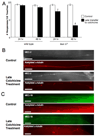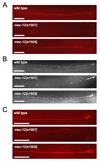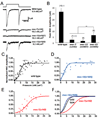The multipurpose 15-protofilament microtubules in C. elegans have specific roles in mechanosensation
- PMID: 19615905
- PMCID: PMC2757273
- DOI: 10.1016/j.cub.2009.06.036
The multipurpose 15-protofilament microtubules in C. elegans have specific roles in mechanosensation
Abstract
Because microtubules perform many essential functions in neurons, delineating unique roles attributable to these organelles presents a formidable challenge. Microtubules endow neurons with shape and structure and are required for developmental processes including neurite outgrowth, intracellular transport, and synapse formation and plasticity; microtubules in sensory neurons may be required for the above processes in addition to a specific sensory function. In Caenorhabditis elegans, six touch receptor neurons (TRNs) sense gentle touch and uniquely contain 15-protofilament microtubules. Disruption of these microtubules by loss of either the MEC-7 beta-tubulin or MEC-12 alpha-tubulin or by growth in 1 mM colchicine causes touch insensitivity, altered distribution of the touch transduction channel, and a general reduction in protein levels. We show that the effect on touch sensitivity can be separated from the others; microtubule depolymerization in mature TRNs causes touch insensitivity but does not result in protein distribution and production defects. In addition, the mec-12(e1605) mutation selectively causes touch insensitivity without affecting microtubule formation and other cellular processes. Touching e1605 animals produces a reduced mechanoreceptor current that inactivates more rapidly than in wild-type, suggesting a specific role of the microtubules in mechanotransduction.
Figures




References
-
- Gordon-Weeks PR. Microtubules and growth cone function. J. Neurobiol. 2004;58:70–83. - PubMed
-
- Goldstein LS, Yang Z. Microtubule-based transport systems in neurons: the roles of kinesins and dyneins. Annu. Rev. Neurosci. 2000;23:39–71. - PubMed
-
- Chang Q, Balice-Gordon RJ. highwire, rpm-1, and futsch: balancing synaptic growth and stability. Neuron. 2000;26:287–290. - PubMed
-
- Bianchi M, Hagan JJ, Heidbreder CA. Neuronal plasticity, stress and depression: involvement of the cytoskeletal microtubular system? Curr. Drug Targets CNS Neurol. Disord. 2005;4:597–611. - PubMed
-
- Chalfie M, Sulston J. Developmental genetics of the mechanosensory neurons of Caenorhabditis elegans. Dev. Biol. 1981;82:358–370. - PubMed
Publication types
MeSH terms
Substances
Grants and funding
LinkOut - more resources
Full Text Sources

